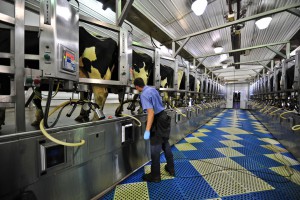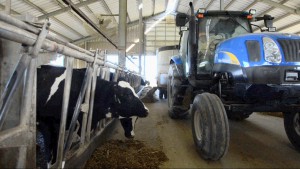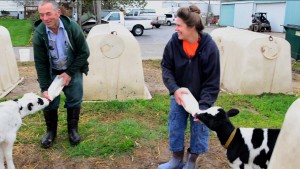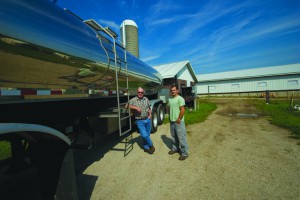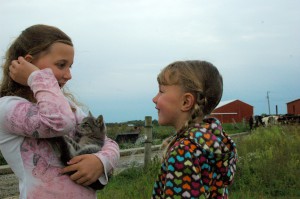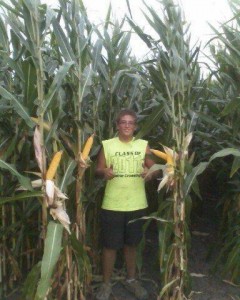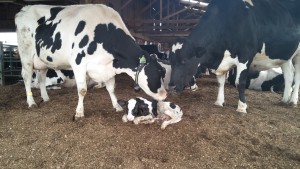(Note: One of my favorite things about dairy farms is that no two farms are exactly alike, so a schedule could vary widely from farm to farm. This is just an example.)
3 a.m.
Rise and shine! Unless you are a robotic dairy farmer (like Sommer Dairy Farm in Berne, Indiana), you begin your day pretty early. First on the agenda: milking the cows. Each cow spends less than 10 minutes in the milking parlor, but depending on the size of the milking parlor and how many cows need milked, it can take the farmers several hours to finish milking.
6 a.m.
Breakfast time! No, not for you–for the cows. Time to go put the morning feed out so cows can enjoy a nice breakfast after milking. Make sure you check the water troughs to make sure they aren’t frozen and are full of fresh, clean water.
7 a.m.
Ok, maybe you have time to grab some breakfast now. Since 98 percent of dairy farms are family owned, this is also probably the time you are waking up children and getting them dressed, fed and ready for the bus.
8 a.m.
Time for the other kids on the farm–the baby calves. These hungry little ladies need their bottles of warm milk. Make sure to give them fresh, clean water, add some extra straw to their pens, and give them a little calf starter, too (calf starter is like baby food, a first step to eating big-cow food). This would also be the moment to look over the baby calves and make sure everyone is healthy. Just like young children, young calves are more prone to getting colds and so need to be monitored closely.
10 a.m.
Are you done feeding calves yet? If it’s really cold outside, you may have had to keep running back and forth to keep the bottles warm enough for the delicate babies. Hurry up! You’re running late.
10:30 a.m.
The milk truck arrives! It’ll take the driver some time to get your milk loaded on to the truck that will take it to the dairy plant.
11 a.m.
Better head out to the barn to check on the cows. This would be a good time to rearrange the cow’s food so it’s easier for them to reach after they’ve nosed through it during breakfast. Many farms use pedometers to measure how many steps cows take each day–farmers can pull up a list of the very active and very inactive cows. The inactive cows may not be feeling very well, so they’ll get some extra attention.
11:45 a.m.
You were heading back up the house for lunch when a salesman pulls in the driveway. Dairy farms create a lot of economic activity in rural areas by creating jobs and using local services. You’re going to lose some time while the salesman tells you about his latest and greatest products.
12:15 p.m.
Just enough time to grab a bite of lunch.
12:45 p.m.
Your dairy nutritionist arrives to analyze your cows’ food. Dairy farmers work with a nutritionist to make sure the cows are getting all the nutrients they need to be healthy and happy.
2 p.m.
Your veterinarian arrives to do a herd health check. Vets come out to dairy farms routinely to make sure everything is going well. Vets also check pregnant cows to make sure the mother and calf are healthy.
2:45 p.m.
Your milk inspector from the Indiana State Board of Animal Health arrives! Dairy farms are inspected at least twice a year by the Board of Animal Health (BOAH for short). These inspectors make sure farms are in compliance with all sanitation requirements. Milk is one of the safest, most regulated foods you can buy.
3 p.m.
While the milk inspector finishes the report, it’s time to start milking again. Most farms milk twice a day with each milking about twelve hours apart. Some farms milk three times a day, with milkings eight hours apart.
3:50 p.m.
The kids are home from school! They can come into the parlor to help you finish milking. Most dairy farms are multi-generational family legacies. These kids could be the future owners of this farm when they’ve grown up.
6 p.m.
Milking is over, time to feed the baby calves again. With some help from your kids, you can get done faster.
7 p.m.
Before it gets too dark, you do a quick drive by your corn and hay fields to make sure everything looks good. Tomorrow you may want to look a little more closely at how your corn crop is getting along–after all, it’s next year’s food for your cows.
7:45 p.m
Time for dinner. The kids also need to get their homework done and get ready for bed.
9 p.m.
It’s bed time. After all, you’ll be up in six hours to milk tomorrow morning.
11 p.m.
A cow is having trouble giving birth, so you have to run down to the barn to play midwife.
11:30 p.m.
The calf is healthy and the mom is on the mend. It’s time to feed the calf her first bottle of colostrum (the mother’s first milk). Colostrum has a lot of antibodies in it that help boost the baby’s immune system.
12 a.m.
Back to bed. Only three more hours before the day begins.

